Coulomb's Law and Electric Field
advertisement
Electric Field of a Continuous Charge Distribution
A ring of radius a carries a charge whose density varies directly proportional to the angular
position between the points zero and 2π there is a very thin membrane of an insulator material
separating these two points. Calculate the electric field vector at a point P on the
symmetry axis perpendicular to the plane of the ring at a distance z from its center.
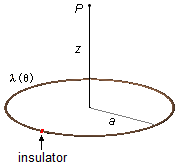
A square loop of side a carries a uniformly distributed charge Q. Determine the electric
field vector at points on the line perpendicular to the plane of the loop at a distance z from
its center.
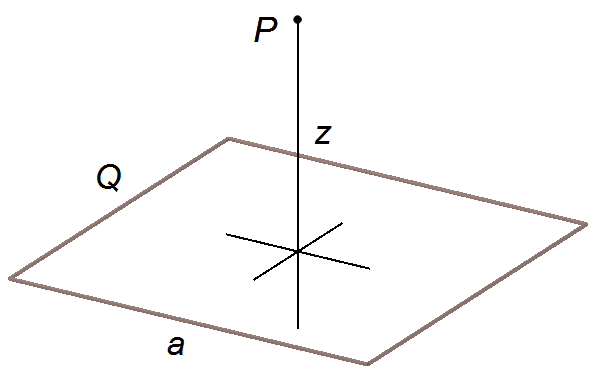
A disk of radius a carries a uniformly distributed charge Q. Calculate the electric field
vector:
a) At a point P on the axis of symmetry perpendicular to the plane of the disk at a distance z from its center;
b) In the case that the radius a of the disk is much greater than the distance from the point P to the disk, a>>z.
a) At a point P on the axis of symmetry perpendicular to the plane of the disk at a distance z from its center;
b) In the case that the radius a of the disk is much greater than the distance from the point P to the disk, a>>z.

Solution with element of area obtained by geometry
Solution with element of area obtained by Jacobian
Solution with element of area obtained by Jacobian
A hemispherical bowl of radius a carries a uniformly distributed charged Q. Calculate the
electric field vector at a point P in the center of the hemisphere base.
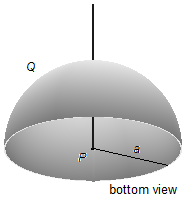
Solution with element of area obtained by geometry
Solution with element of area obtained by Jacobian
Solution with element of area obtained by Jacobian
A disk of radius a has at the center a hole of radius b and carries a uniformly
distributed charge Q. Calculate the electric field vector at a point P on the symmetry
axis perpendicular to the plane of the disk at a distance z from its center.
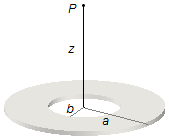
Solution with element of area obtained by geometry
Solution with element of area obtained by Jacobian
Solution with element of area obtained by Jacobian
A semicircular plate has an outer radius of a and an inner radius of b. The plate carries
a total charge Q distributed non uniformly, the charge is directly proportional to the central
angle θ that a semicircle
\( 0 \leq \theta \leq \pi \).
Calculate the electric field vector at a point P on the axis of the semicircle perpendicular to
the plane passing through the center of curvature at a distance z from its center.
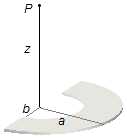
Solution with element of area obtained by geometry
Solution with element of area obtained by Jacobian
Solution with element of area obtained by Jacobian
A disk of radius a carries a charge whose density varies directly proportional to the radial
position. Calculate the electric field vector at a point P on the symmetry axis perpendicular to
the plane of the disk at a distance z of its center.
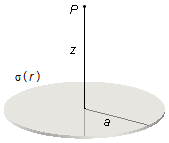
Solution with element of area obtained by geometry
Solution with element of area obtained by Jacobian
Solution with element of area obtained by Jacobian
A wire is folded in a semicircular form of radius a, this wire carries a uniformly distributed charge
Q. At point P, in the center of the semicircle, this distribution of charges produces an
electric field of magnitude E1.
If the wire is substituted by a point charge of the same value Q and at a distance a, equal to the radius of the semicircle, from the point P it produces at this point an electric field of magnitude E2.
Calculate the ratio E1/E2, between the magnitudes of the electric fields produced by semicircular charges and by the point charge.

If the wire is substituted by a point charge of the same value Q and at a distance a, equal to the radius of the semicircle, from the point P it produces at this point an electric field of magnitude E2.
Calculate the ratio E1/E2, between the magnitudes of the electric fields produced by semicircular charges and by the point charge.

advertisement

Fisicaexe - Physics Solved Problems by Elcio Brandani Mondadori is licensed under a Creative Commons Attribution-NonCommercial-ShareAlike 4.0 International License .